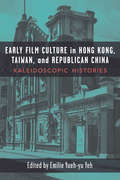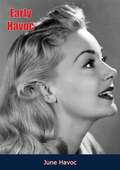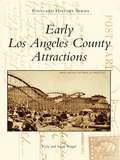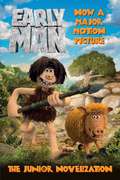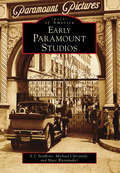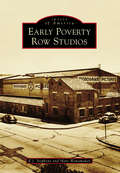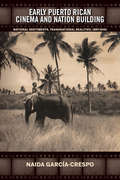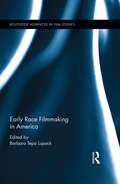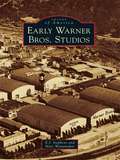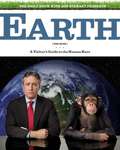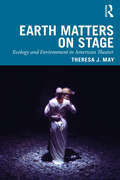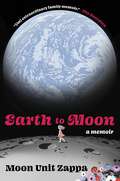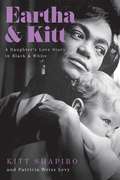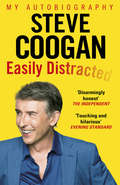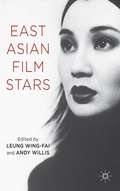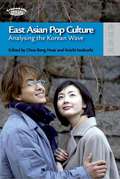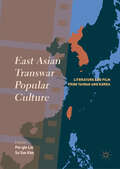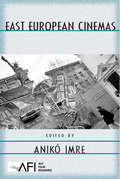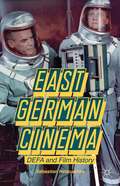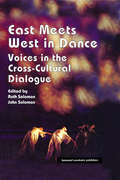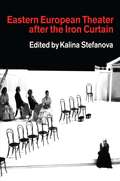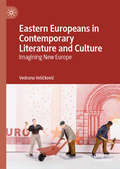- Table View
- List View
Early Film Culture in Hong Kong, Taiwan, and Republican China: Kaleidoscopic Histories
by Emilie Yueh-yu YehThis volume features new work on cinema in early twentieth-century Hong Kong, Taiwan, and Republican China. Looking beyond relatively well-studied cities like Shanghai, these essays foreground cinema’s relationship with imperialism and colonialism and emphasize the rapid development of cinema as a sociocultural institution. These essays examine where films were screened; how cinema-going as a social activity adapted from and integrated with existing social norms and practices; the extent to which Cantonese opera and other regional performance traditions were models for the development of cinematic conventions; the role foreign films played in the development of cinema as an industry in the Republican era; and much more.
Early Havoc
by June HavocShe could dance on her toes when she was eighteen months old (and by heaven she had to!).June Havoc is the famous younger sister of Gypsy Rose Lee, and the daughter of Mrs. Rose Hovick, whose life story was fancifully portrayed by Ethel Merman in the 1959 smash-hit Broadway musical Gypsy.In Early Havoc, June tells quite another story, the inside story of a ruthless, conscienceless, ambition-driven woman who stripped her own daughters of their childhood. Early Havoc is a book that gets beneath the glitter of “show biz,”, and reveals the savage reality, as only the real autobiography of a trouper can.“A remarkable show-business document that might be titled ‘How to Make Good in Spite of Mother, Men and Marathons!’—TIME“Tensely dramatic…these are the years in which a child and a girl were beaten, pounded and shaped into womanhood.”—New York Herald Tribune
Early Los Angeles County Attractions
by Cory Stargel Sarah StargelWith the arrival of affordable transcontinental rail travel in the late 1880s, hundreds of thousands of tourists and transplants began making the trip to Los Angeles. Quickly becoming a haven for Easterners escaping cold winters and crowded cities, Los Angeles and neighboring communities, such as Pasadena and Santa Monica, boasted a sunny Mediterranean climate and the unique situation of both nearby mountain resorts and seaside amusements. The city also developed a bustling shopping and entertainment district downtown. More than 200 vintage postcard images illustrate a greatly diverse range of popular early attractions, including Mount Lowe, Eastlake Park, Hollywood, the Wilshire district, Griffith Park, Cawston's Ostrich Farm, the downtown shopping and theater district, and the expansive beaches, ranging from the turn of the 19th century up until World War II.
Early Man: The Junior Novelization
by Aardman Animation LtdThe official novelization of the major stop-motion children's movie!Based on the hotly anticipated new stop-motion feature film Early Man, from director Nick Park (Shaun the Sheep, Wallace and Gromit, Chicken Run) and Aardman Animation, coming to U.S. theaters this February.Meet Dug, a scrawny but cheerful caveman who loves his valley and just wants the best for his tribe of misfits. Accompanied by his faithful pig sidekick Hognob, Dug is a dreamer—why settle for hunting rabbits when you can hunt a mammoth?! Then there’s Dug’s tribe, led by the cautious Chief Bobnar. Bobnar wants the best for the tribe, too, but he sees things a little differently from Dug.Then Dug meets the evil Lord Nooth. He’s the leader of the Bronze Age City. When the Bronze Age City invades the valley and the cavemen have to fight to save their home, Dug strikes a deal with Lord Nooth. The tribe can keep their valley if they beat the Bronze Agers at their own game: soccer!Can Dug and Hognob really unite a motley tribe of rabbit-hunters into a serious team? It’s the Stone Age versus the Bronze Age in the match of the millennium!Easy to read and side-splittingly funny, this story about cavemen with heart will appeal to young readers and their parents.
Early Paramount Studios
by Marc Wanamaker E. J. Stephens Michael ChristaldiFor over 100 years, Paramount Pictures has been captivating movie and television audiences worldwide with its alluring imagery and compelling stories. Arising from the collective genius of Adolph Zukor, Jesse L. Lasky, and Cecil B. DeMille during the 1910s, Paramount Pictures is home to such enduring classics as Wings, Sunset Boulevard, The Ten Commandments, Love Story, The Godfather, the Indiana Jones series, Chinatown, Forrest Gump, Braveheart, Titanic, and Star Trek. Early Paramount Studios chronicles Paramount's origins, culminating in the creation and expansion of the lot at 5555 Melrose Avenue, the last major motion picture studio still in Hollywood.
Early Poverty Row Studios
by Marc Wanamaker E. J. StephensThe history of Hollywood is often seen only through the lens of the major studios, forgetting that many of Tinseltown's early creations came from micro-studios stretched along Sunset Boulevard in an area disparagingly known as Poverty Row. Here, the first wave of West Coast moviemakers migrated to the tiny village of Hollywood, where alcohol was illegal, actors were unwelcome, and cattle were herded down the unpaved streets. Most Poverty Row producers survived from film to film, their fortunes tied to the previous week's take from hundreds of nickelodeon tills. They would routinely script movies around an event or disaster, often creating scenarios using sets from more established productions, when the bosses weren't looking, of course. Poverty Row quickly became a generic term for other fly-by-night studios throughout the Los Angeles area. Their struggles to hang on in Hollywood were often more intriguing than the serialized cliffhangers they produced.
Early Puerto Rican Cinema and Nation Building: National Sentiments, Transnational Realities, 1897-1940 (Bucknell Studies in Latin American Literature and Theory)
by Naida García-CrespoEarly Puerto Rican Cinema and Nation Building focuses on the processes of Puerto Rican national identity formation as seen through the historical development of cinema on the island between 1897 and 1940. Anchoring her work in archival sources in film technology, economy, and education, Naida García-Crespo argues that Puerto Rico’s position as a stateless nation allows for a fresh understanding of national cinema based on perceptions of productive cultural contributions rather than on citizenship or state structures. This book aims to contribute to recently expanding discussions of cultural networks by analyzing how Puerto Rican cinema navigates the problems arising from the connection and/or disjunction between nation and state. The author argues that Puerto Rico’s position as a stateless nation puts pressure on traditional conceptions of national cinema, which tend to rely on assumptions of state support or a bounded nation-state. She also contends that the cultural and business practices associated with early cinema reveal that transnationalism is an integral part of national identities and their development. García-Crespo shows throughout this book that the development and circulation of cinema in Puerto Rico illustrate how the “national” is built from transnational connections. Published by Bucknell University Press. Distributed worldwide by Rutgers University Press.
Early Race Filmmaking in America (Routledge Advances in Film Studies)
by Barbara LupackThe early years of the twentieth century were a formative time in the long history of struggle for black representation. More than any other medium, movies reflected the tremendous changes occurring in American society. Unfortunately, since they drew heavily on the nineteenth-century theatrical conventions of blackface minstrelsy and the "Uncle Tom Show" traditions, early pictures persisted in casting blacks in demeaning and outrageous caricatures that marginalized and burlesqued them and emphasized their comic or servile behavior. By contrast, race films—that is, movies that were black-cast, black-oriented, and viewed primarily by black audiences in segregated theaters—attempted to counter the crude stereotyping and regressive representations by presenting more authentic racial portrayals. This volume examines race filmmaking from numerous perspectives. By reanimating a critical but neglected period of early cinema—the years between the turn-of-the-century and 1930, the end of the silent film era—it provides a fascinating look at the efforts of early race film pioneers and offers a vibrant portrait of race and racial representation in American film and culture.
Early Stages: Scenes from a Life
by Anne JacksonAutobiography: In this charming childhood memoir Anne Jackson tells the fetching, poignant tale of how a spunky little red-haired kid made her way from a backyard talent show to Broadway, to become one of the most accomplished and respected actresses of our time.
Early Warner Bros. Studios
by Marc Wanamaker E. J. StephensSince 1928, Warner Bros. has produced thousands of beloved films and television shows at the studio's magical 110-acre film factory in Burbank. This collection of evocative images concentrates on the Warner Bros. legacy from the 1920s to the 1950s, when timeless classics such as Casablanca, The Maltese Falcon, and East of Eden came to life. It also looks at WB's earlier homes along Hollywood's "Poverty Row," the birthplace of Looney Tunes, and the site of WB's pioneering marriage between film and sound in the 1920s. Early Warner Bros. Studios also tells the tale of four brothers--Harry, Albert, Sam, and Jack Warner--scions of a Polish Jewish immigrant family who rose from the humblest of origins to become Hollywood moguls of enormous and lasting influence.
Earth (The Book): A Visitor's Guide to the Human Race
by Jon StewartThe eagerly awaited new book from the Emmy-winning, Oscar-hosting, Daily Show- anchoring Jon Stewart--the man behind the megaseller America (The Book). Where do we come from? Who created us? Why are we here? These questions have puzzled us since the dawn of time, but when it became apparent to Jon Stewart and the writers of The Daily Show that the world was about to end, they embarked on a massive mission to write a book that summed up the human race: What we looked like; what we accomplished; our achievements in society, government, religion, science and culture -- all in a tome of approximately 256 pages with lots of color photos, graphs and charts. After two weeks of hard work, they had their book. EARTH (The Book) is the definitive guide to our species. With their trademark wit, irreverence, and intelligence, Stewart and his team will posthumously answer all of life's most hard-hitting questions, completely unburdened by objectivity, journalistic integrity, or even accuracy.
Earth Matters on Stage: Ecology and Environment in American Theater (Routledge Studies in Theatre, Ecology, and Performance)
by Theresa J. MayEarth Matters on Stage: Ecology and Environment in American Theater tells the story of how American theater has shaped popular understandings of the environment throughout the twentieth century as it argues for theater’s potential power in the age of climate change. Using cultural and environmental history, seven chapters interrogate key moments in American theater and American environmentalism over the course of the twentieth century in the United States. It focuses, in particular, on how drama has represented environmental injustice and how inequality has become part of the American environmental landscape. As the first book-length ecocritical study of American theater, Earth Matters examines both familiar dramas and lesser-known grassroots plays in an effort to show that theater can be a powerful force for social change from frontier drama of the late nineteenth century to the eco-theater movement. This book argues that theater has always and already been part of the history of environmental ideas and action in the United States. Earth Matters also maps the rise of an ecocritical thought and eco-theater practice – what the author calls ecodramaturgy – showing how theater has informed environmental perceptions and policies. Through key plays and productions, it identifies strategies for artists who want their work to contribute to cultural transformation in the face of climate change.
Earth to Moon: A Memoir
by Moon Unit ZappaFrom Moon Unit Zappa, the daughter of musical visionary Frank Zappa, comes a memoir of growing up in her unconventional household in 1970s Los Angeles, coming of age in the Hollywood Hills in the 1980s as the “Valley Girl,” gaining momentum as an accidental VJ on a new network called MTV, and finding herself after losing her father, then her mother, and the testing of her most important relationships.How can you navigate life as the “normal” child of an extraordinary creative? What is it like to live in a hothouse of individuality that on one hand fosters freedom of expression, and on the other tamps down the basic desires of a child for boundaries and affection? Should you call your parents Frank and Gail from birth? For Moon Unit Zappa, processing a life so punctuated by the whims of genius, the tastes of popular culture, the calculus of celebrity, and the nature of love, was at times eviscerating, at times illuminating—but mostly deeply confusing. Yes, this is a book about growing up in the shadow of Frank Zappa. Moon and her family were a source of constant curiosity, for their unique names and for their father’s reputation as a musical savant and fierce protector of the First Amendment, even though he was never a commercial success. Searching for her own path, first as her father’s inadvertent musical collaborator and public sidekick with their surprise mega radio hit, then as an actress, an artist, a spiritual person, a wife and mother, Moon Unit calculates ever-changing equations of fame, family, death and ultimately legacy when dealt the shocking news that Gail’s will established an unequal distribution among the remaining, tight-knit Zappas, catalyzing a quest for meaning and redemption. With love, humor, and humility, Earth to Moon reminds us that every family is faced with problems that are unique to their particular makeup, but the journey to growing into yourself with grace is as universal as it gets.
Eartha & Kitt: A Daughter's Love Story in Black and White
by Kitt ShapiroA luminous and inspiring portrait of a Black pioneer and artistic force—Eartha Kitt—and one of the most moving mother/daughter stories in Hollywood history.In this unique combination of African-American, music, and cultural history, we come to know one of the greatest stars the world has ever seen—Eartha Kitt—as revealed by the person who knew her best, her daughter. Eartha, who was a mix of Black, Cherokee, and white, identified as Black, but Kitt, her biological daughter by a white man, is blonde and pale. This is the story of a little white girl raised by her natural mother, who was the biggest Black celebrity in the world. For three decades until Kitt finally married, they traveled the world together, mother and daughter. Eartha came from a hard background (she was born on a cotton plantation) and did not have her own familial ties to lean on—she and Kitt were each others whole world. Eartha&’s legacy is still felt today. Not only do we still listen to &“Santa Baby&” every Christmas, she starred as Helen of Troy opposite Orson Welles in "Dr. Faustus" and stole the show in The Emperor's New Groove. Lupita Nyong'o was recently asked to name the two people she admired most. Her choices were Eartha Kitt and Katherine Hepburn. In these pages, Eartha Kitt comes to life so vividly you will feel as if you'd met her. FIlled with love and poignant laughter, Eartha & Kit captures the passion and energy of two remarkable women.
Easily Distracted
by Steve CooganSteve Coogan was born and raised in Manchester in the 1960s, the fourth of six children. From an early age he entertained his family with impressions and was often told he should 'be on the telly'. Failing to get into any of the London-based drama schools, he accepted a place at Manchester Polytechnic School of Theatre and before graduating had been given his first break as a voice artist on the satirical puppet show Spitting Image. The late eighties and early nineties saw Coogan developing characters he could perform on the comedy circuit, from Ernest Moss to Paul Calf, and in 1992 he won a Perrier award with John Thomson. It was around the same time, while working with Armando Iannucci and Patrick Marber on On The Hour and The Day Today, that Alan Partridge emerged, almost fully formed. Coogan, once a tabloid fixture, is now a respected film actor, writer and producer. He runs his own production company, Baby Cow, has a raft of films to his name (from 24 Hour Party People to Alpha Papa, the critically-acclaimed Partridge film), six Baftas and seven Comedy Awards. He has found huge success in recent years with both The Trip and Philomena, the latter bringing him two Oscar nominations, for producing and co-writing.In Easily Distracted he lifts the lid on the real Steve Coogan, writing with distinctive humour and an unexpected candour about a noisy childhood surrounded by foster kids, his attention-seeking teenage years and his emergence as a household name with the birth of Alan Partridge.
East Asian Film Stars
by Leung Wing-Fai Andy WillisMany stars from China, Japan and Korea are the most popular and instantly recognizable in the world. East Asian Film Stars brings together some of the world's leading cinema scholars to offer their insights into the work of regional and transnational screen legends, contemporary superstars and mysterious cult personas.
East Asian Pop Culture
by Chua Beng HuatThe International group of contributors of this volume provides, collectively, a multi-layered analysis of the emerging East Asian media culture, using the Korean TV drama as its analytic vehicle. By closely examining the political economy of TV industry, audiences of the regional media flows in terms of gender subjectivity constructions, perceptions of colonial-postcolonial relationships, and nationalist responses to trans-national media culture exchanges, this volume highlights the multiple connectivities and implications of popular cultural flows and exchanges in East Asia.
East Asian Transwar Popular Culture: Literature and Film from Taiwan and Korea
by Pei-Yin Lin Su Yun KimThis collection examines literature and film studies from the late colonial and early postcolonial periods in Taiwan and Korea, and highlights the similarities and differences of Taiwanese and Korean popular culture by focusing on the representation of gender, genre, state regulation, and spectatorship. Calling for the “de-colonializing” and “de–Cold Warring” of the two ex-colonies and anticommunist allies, the book places Taiwan and Korea side by side in a “trans-war” frame. Considering Taiwan–Korea relations along a new trans-war axis, the book focuses on the continuities between the late colonial period’s Asia-Pacific War and the consequent Korean War and the ongoing conflict between the two sides of the Taiwan Strait, facilitated by Cold War power struggles. The collection also invites a meaningful transcolonial reconsideration of East Asian cultural and literary flows, beyond the conventional colonizer/colonized dichotomy and ideological antagonism.
East European Cinemas (AFI Film Readers)
by Anikó ImreFirst Published in 2005. Routledge is an imprint of Taylor & Francis, an informa company.
East German Cinema
by Sebastian HeiduschkeEast Germany's film monopoly, Deutsche Film-Aktiengesellschaft, produced a films ranging beyond simple propaganda to westerns, musicals, and children's films, among others. This book equips scholars with the historical background to understand East German cinema and guides the readers through the DEFA archive via examinations of twelve films.
East German Film and the Holocaust (Film Europa #22)
by Elizabeth WardEast Germany’s ruling party never officially acknowledged responsibility for the crimes committed in Germany’s name during the Third Reich. Instead, it cast communists as both victims of and victors over National Socialist oppression while marginalizing discussions of Jewish suffering. Yet for the 1977 Academy Awards, the Ministry of Culture submitted Jakob der Lügner – a film focused exclusively on Jewish victimhood that would become the only East German film to ever be officially nominated. By combining close analyses of key films with extensive archival research, this book explores how GDR filmmakers depicted Jews and the Holocaust in a country where memories of Nazi persecution were highly prescribed, tightly controlled and invariably political.
East German Film and the Holocaust (Film Europa #22)
by Elizabeth WardEast Germany’s ruling party never officially acknowledged responsibility for the crimes committed in Germany’s name during the Third Reich. Instead, it cast communists as both victims of and victors over National Socialist oppression while marginalizing discussions of Jewish suffering. Yet for the 1977 Academy Awards, the Ministry of Culture submitted Jakob der Lügner – a film focused exclusively on Jewish victimhood that would become the only East German film to ever be officially nominated. By combining close analyses of key films with extensive archival research, this book explores how GDR filmmakers depicted Jews and the Holocaust in a country where memories of Nazi persecution were highly prescribed, tightly controlled and invariably political.
East Meets West in Dance: Voices in the Cross-Cultural Dialogue (Choreography and Dance Studies Series #Vol. 9)
by Ruth Solomon John SolomonFirst Published in 1995. Routledge is an imprint of Taylor & Francis, an informa company.
Eastern European Theatre After the Iron Curtain (Contemporary Theatre Studies #Vol. 30)
by Kalina Stefanova Ann WaughAn important new survey of Eastern European theater after the collapse of the Soviet Union. Explores all aspects of theater, from playwriting, directing and acting, to repertoire creation and theatre management. Uses material never previously published on theatre life during the Communist years. Compares theater before and after the political changes in Albania, Bulgaria, Czech Republic, Hungary, Latvia, Lithuania, Moldova, Poland,Romania, Russia, Slovakia, Ukraine. Chapters begin with introductions by well-known theatre professionals or lively interviews with a major directors or playwrights - including Yury Lyubimov, Václav Havel, Andrei Sherban and Ismail Kadare.
Eastern Europeans in Contemporary Literature and Culture: Imagining New Europe
by Vedrana VeličkovićEastern Europeans in Contemporary Literature and Culture: Imagining New Europe provides a comprehensive study of the way in which contemporary writers, filmmakers, and the media have represented the recent phenomenon of Eastern European migration to the UK and Western Europe following the enlargement of the EU in the 21st century, the social and political changes after the fall of communism, and the Brexit vote. Exploring the recurring figures of Eastern Europeans as a new reservoir of cheap labour, the author engages with a wide range of both mainstream and neglected authors, films, and programmes, including Rose Tremain, John Lanchester, Marina Lewycka, Polly Courtney, Dubravka Ugrešić, Kapka Kassabova, Kwame Kwei-Armah, Mike Phillips, It’s a Free World, Gypo, Britain’s Hardest Workers, The Poles are Coming, and Czech Dream. Analyzing the treatment of Eastern Europeans as builders, fruit pickers, nannies, and victims of sex trafficking, and ways of resisting the stereotypes, this is an important intervention into debates about Europe, migration, and postcommunist transition to capitalism, as represented in multiple contemporary cultural texts.
